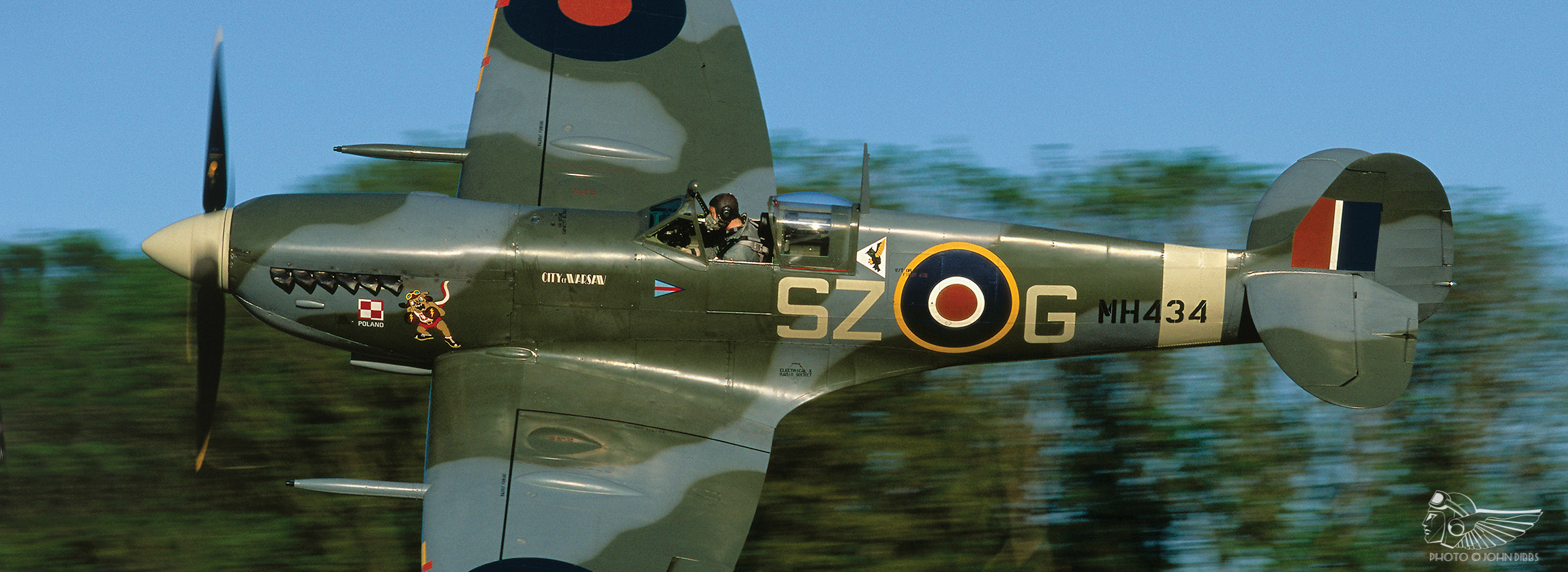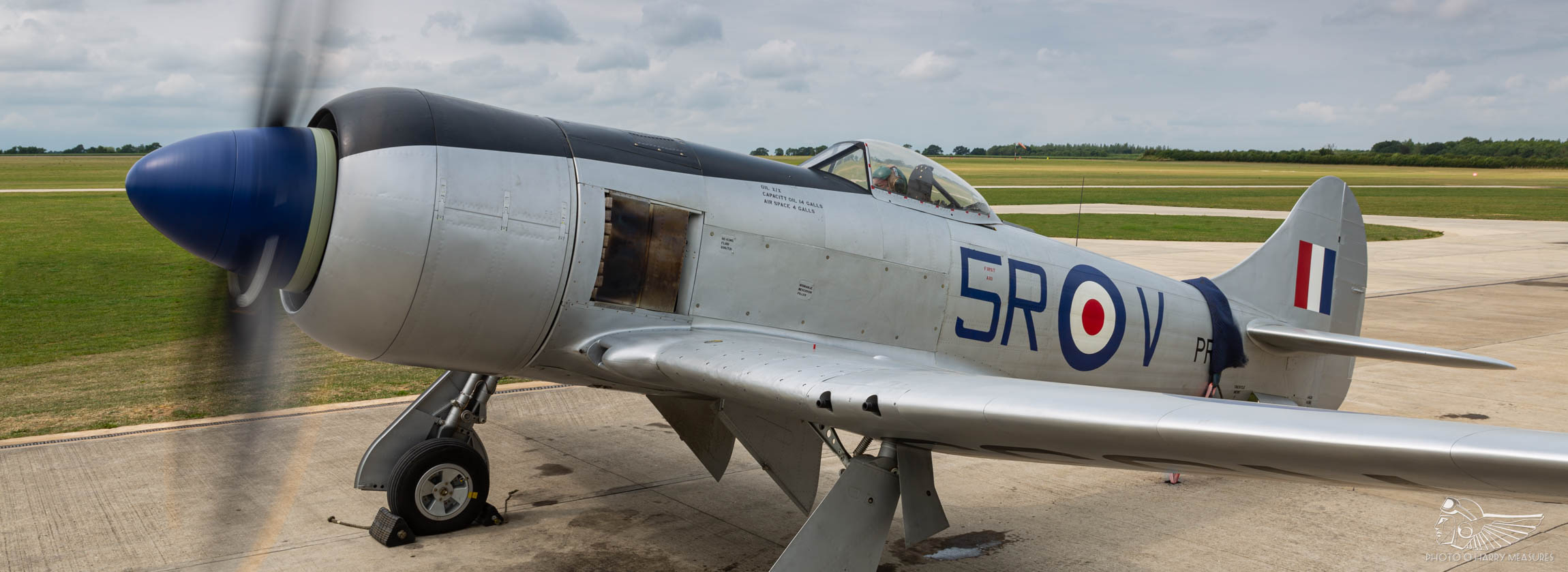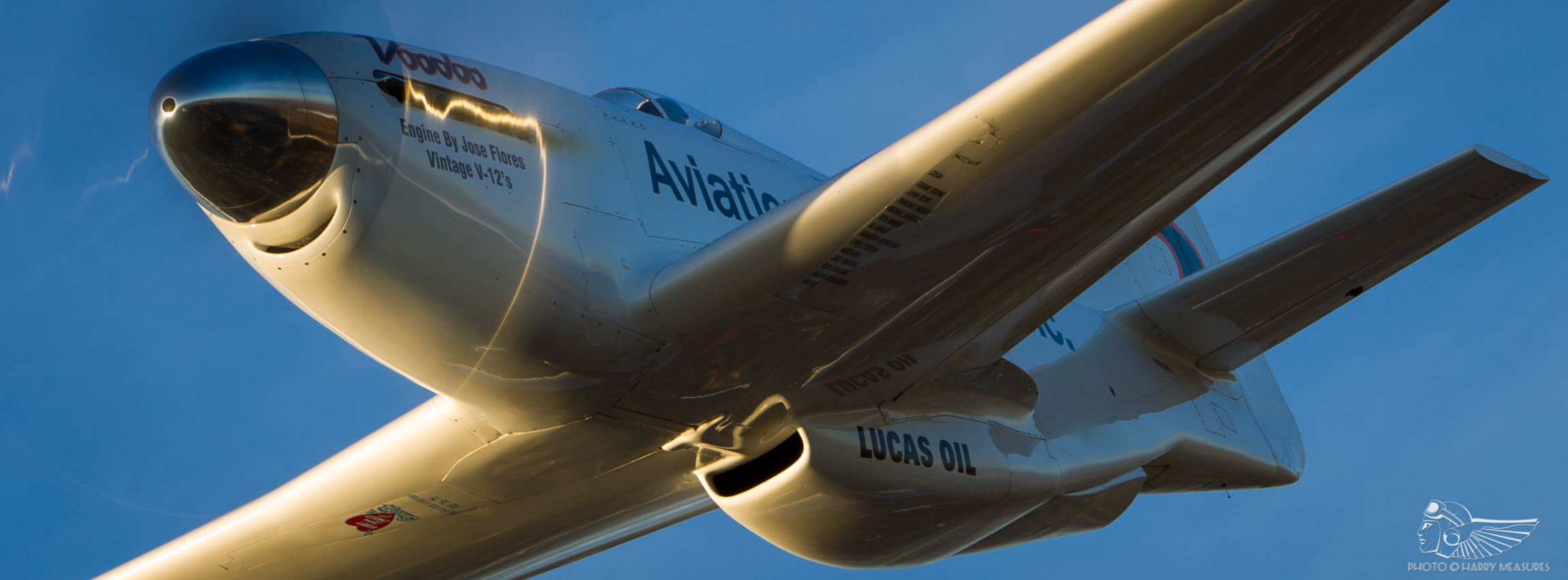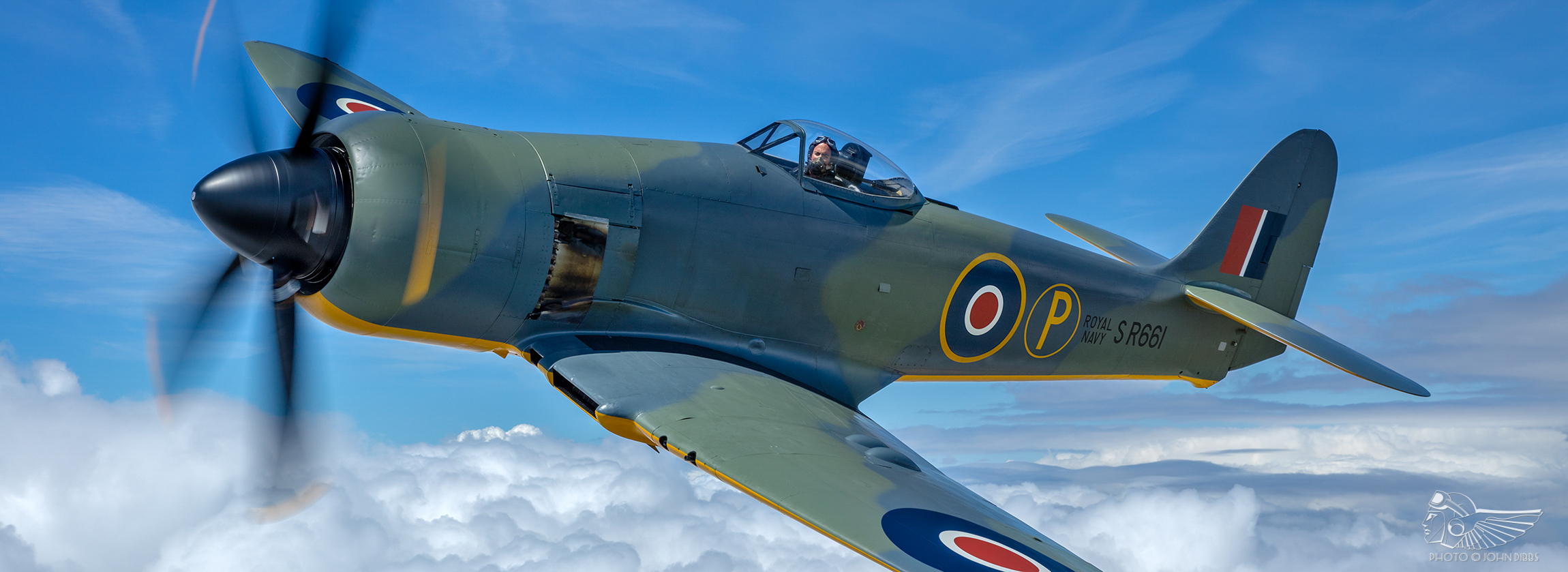Mark Ashley Hanna was born in Berkshire on 6 August 1959 to Ray and Eunice. By the age of six he was, in his father’s words, “a total aviation freak, absolutely sold on aeroplanes”.
“If ever there was a boy with aviation in his blood!” laughs his younger sister Sarah. “Every waking moment was spent either playing at being a pilot or studying aviation and military history.”
Taught to fly by his father from an idyllic coral strip in the Philippines, Mark went solo at the age of 17. Like his father, a career in the armed forces beckoned and enlistment in the Royal Air Force followed a year later. “Mark’s natural talent was clear to see”, his former Flight Commander Cliff Spink recollects, “and one got the sense that he was destined for great things”. Mark flew the Phantom on QRA duty over the North Sea and on deployment to the Falkland Islands, whilst co-founding a private collection of vintage aeroplanes at Duxford under the Old Flying Machine Company banner. Early retirement from the air force in 1988 allowed him to concentrate on his true passion, which he did insatiably as Managing Director of OFMC for the next decade.
First he flew the family Spitfire, then the Kittyhawk and Mustang. The pages of his logbook came to reflect a terrific breadth and depth of classic fighter experience, from Fokker D.VII to Messerschmitt Bf 109, and I-16 Rata to Yak-3. Some 2,300 of his 4,000 hours were flown on historic aircraft. Within a short span of years, Brian Smith says, Mark had become “part of the Hanna flying legend”. John Farley called him “one of the most accomplished warbird display pilots who ever lived”, while aerial filming specialist Simon Werry, who worked alongside the Hannas on dozens of film and television projects, assesses that “Mark was equal to his father in skill and judgement – he never lived in Ray’s shadow”.
By sheer force of talent, Mark asserted himself into the highly competitive film and television industry. Be it Michael Caton-Jones’ Memphis Belle or James Bond film Tomorrow Never Dies, Mark’s dynamic flying was a true co-star in many a Hollywood production. His ability to “handle the serious friction of a film production quietly and calmly”, says aerial coordinator Marc Wolff, “with utmost professionalism and integrity” was a testament to the values he inherited from his father.
“Their bond was inspirational”, says Nigel Lamb. “More like brothers or best friends than father and son.” Mark, like his father, was the model aviator – one who set the tone and led by example, generous with his time and eager to share his privilege with others, yet prepared to learn. “My father and my brother were their flying”, Sarah Hanna offers, “insofar as the way they flew said everything about their character.”
Mark’s death following a landing accident in autumn 1999 was a cruel blow to the historic aviation scene, and an incomprehensible loss for his friends and family. An outstanding aviator and a warm, funny and kind-hearted friend, he lived his life with undimmed passion until his final day. “It’s the conversations I remember and miss to this day”, adds Nick Grey. “We had hundreds of chats just sat on the grass under a wing, dreaming about what comes next in our voyage of discovery through aeroplanes of that golden era. I still think of him a lot. I hear his voice in my head very clearly every now and then.”
Air display veteran Barry Tempest claims that under Ray and Mark’s watch, OFMC raised the bar where the operation of warbirds was concerned. When Mark died, Tempest says, he shed tears for a good friend. “A bright star in the airshow firmament had been extinguished.”
It was a heartbreak from which Ray never truly recovered. Yet he pressed on, carrying the OFMC legacy into the future until his death in winter 2005. “He pushed on through unimaginable pain. He couldn’t not”, says Sarah. “Good for him.” Ray is buried beside his son at St Mary’s Church, Parham, atop a hill overlooking the cemetery and beautiful rolling hills of Suffolk beyond. His headstone reads, quite simply, ‘Incomparable’. The word could apply equally to father and son. The Hanna flying legend.
A New Zealand native born on 28 August 1928 and raised in Takapuna, the young Ray Hanna spent many a weekend at Mangere aerodrome (now Auckland Airport) on the Tasman coast watching the local de Havilland biplanes through the fence. It wasn’t a foregone conclusion that he would pursue a flying career – he wasn’t born into an aviation family – but visits to the local grass airstrip with his parents unlocked a yearning to fly. Once he reached his teens, he joined the local Air Training Corps. “All I wanted to do was fly in military aeroplanes”, Hanna told the late aviation journalist Mike Jerram, “so 1945 was a sad time for me. You know how it is when you are 17 or 18 – you don’t think about other people’s lives”.
It remained Ray’s ambition to fly for the Royal New Zealand Air Force. A new basic flying training scheme for qualifying ATC cadets was introduced in 1947 to help establish the Territorial Air Force (equivalent to the Royal Auxiliary Air Force). Ray was amongst the intake, flying the de Havilland Tiger Moth under the tutelage of ex-military veteran instructors; they gave Ray a fantastic grounding, and he went solo in just over eight hours.
By late 1948, Ray was “fed up with waiting” and wrote to the Air Ministry in London. The Ministry’s response wasn’t particularly encouraging and made no promises of recruitment; undeterred, Ray joined a ship bound for the northern hemisphere and worked his passage to the UK in January 1949. For a small wage he scrubbed the ship’s decks, before fortuitously taking a job book-keeping for the vessel – a skill that would serve him well in later life. Still, the work paid modestly, and Ray arrived in London in spring 1949 with little money to his name. What he had left he spent on flying a Miles Magister from Redhill, which he soloed in an hour and a half.
The Air Ministry had nothing to offer the young New Zealander and asked him to come back in a few months: “I said, sorry, can’t do that, haven’t got any money, so they sent me to Hornchurch, the RAF aircrew selection centre then, and after a month I was invited to join up.” He went first to RAF Feltwell in May 1950, developing his flying experience on the Percival Prentice (the first aeroplane he’d flown in a year, and one he soloed in under four hours) and then the Harvard. In 1951 he was off to Driffield to fly Gloster Meteors, a detachment he described as “just like a summer holiday with tents pitched on the airfield… We were really cock-a-hoop with our Meteor T.7s and F.4s. It was an exceptionally good course with very good instructors”.
Gunnery and formation training with the Meteor Operational Conversion Unit at Stradishall followed. There he found the local fighter reconnaissance OCU in the midst of converting from Spitfire FRXVIIIs to the Meteor FR9. “I quite fancied the idea of low flying all over the place”, he said, “but they told me I didn’t have enough experience to join the fighter recce course. Anyway, I persevered, and either they didn’t attract enough people or they finally relented and after doing the course I was posted to 79 Squadron to do two tours in Germany”.
From RAF Guttesloh, Ray and his colleagues “used to fly everywhere in pairs, always below 100 feet, never above, cruising to the target at 300 to 350 knots. We used to fly around among the trees much more than they do today, and that four years with 79 was my apprenticeship in low flying. In that time we never once had a low-flying accident other than bird strikes, which says something for the quality of the training and the proficiency of the pilots.”
Returning to the UK in 1956, Ray passed a gunnery instructor course at Leconfield’s Fighter Weapons School, but an instructor posting failed to materialise. “They said right my boy, you can go to some place in Cornwall whose name I forget and fly as a co-pilot in Neptunes. Now go away for a week and think about that. Well, I thought about it. I wasn’t going to fly Neptunes, so I came back and asked politely, wasn’t there anything else?”
There was – and it was right up Ray’s alley. The Overseas Ferry Wing at Benson took all of the mainstays across the globe, amongst them Swifts, Javelins and Hunters, including the first 168 Hunters delivered to the Indian Air Force. “The books say the Indians did it themselves, but they’re wrong”, Hanna asserted – he would know, having flown the first of the Hunters to India, operating through Sharjah “where a bit of oil laid on the sand was our runway.” He stayed on for two tours, eventually becoming Flight Commander. There was also a Royal Navy Volunteer Reserve squadron at Benson, and Ray occasionally flew Attackers, Sea Hawks and Sea Furies.
“[The Ferry Wing] was very interesting work. We flew in pairs or fours, and once you left Benson you were totally on your own. If you had a technical problem which wasn’t too serious you fixed it yourself”. Not all flights were uneventful. In October 1956, whilst flying a Vampire to the UK, the jet’s engine failed over India and Ray bellied in a field of giant anthills near a railway line. There he waited until a passing train stopped for him. That wasn’t the end of his woes – Ray couldn’t pay the rail fare, and the train’s guard refused to let him on. Ever the pragmatist, Ray offered up his wrist watch as payment. Satisfied with the deal, the guard wrote out an ‘IOU’ note and welcomed Ray on board.
Benson proved to be a particularly special posting for Ray. There he met Eunice, a young Royal Navy officer whom he married in 1957. The two spent 48 happy years together until Ray’s death parted them. Their first child, Mark, was born in 1959 and daughter Sarah five years later; both inherited their parents’ formidable resolve and generosity of spirit. They were a close-knit family, and the children grew up in a happy and loving home.
Ray’s five-year stint at Benson concluded a 12-year RAF commission. He’d flown a magnificent array of types – Balliol, Tempest, Sea Fury, Beaufighter, Meteor, Swift, Hunter, Javelin, Canberra, Oxford, Anson and Hastings, to name a few. Returning to New Zealand with Mark, he found few aviation jobs available and gave topdressing a try – “I just couldn’t stand it, so after a year I contacted the RAF Attaché in Wellington to see if they’d have me back”.
They did, and he was posted to the Central Flying School and then the College of Air Warfare. With the latter at Manby he flew as number three in an aerobatic trio of Meteor F.8s. “While I was at Benson there were always plenty of surplus Hunters lying around following the Duncan Sandys cuts and we had an informal four-ship team which I led. We managed lots of aerobatic practice, and I also flew a few solo slots at airshows in Hunters and Swifts.” In 1965, Flt Lt Lee Jones, a former Black Arrows pilot and a friend of Ray’s from the Germany years, formed the inaugural Red Arrows at Fairford with seven Folland Gnats on charge. Flt Lt Hanna joined as number three, and the team made its public debut at that year’s Biggin Hill Air Fair.
Ray ascended to team leader in 1966 and led the Arrows for four years. His display flying philosophy set the tone – “if the crowd have time to lick their ice creams, we aren’t doing our jobs properly” was a mantra from which Ray never strayed.
The following year, at Rimini on the Adriatic Coast, Ray got airborne with Red 2, ‘Dinger’ Bell, and the synchro pair for a recce of the airfield. Towards the end of their sortie, the quartet flew a cascade break and buzzed extremely low over the VIP enclosure. Rejoining in the overhead, Ray signalled to Dinger Bell that his radio was u/s. Visual inspection revealed a tear under the fuselage; clearly, Ray had hit something, but the Gnat was repaired and readied for the weekend’s airshow.
On Saturday evening, the pilots gathered for the traditional evening party. The Arrows each received gold medals of thanks from their hosts, and the Frecce Tricolori’s leader added that he had a special award to present to ‘Maggiore Hanna’ – the top of a tall whip aerial Ray had swiped off one of the vehicles during his recce the previous day, mounted on a plinth! It remains in Ray’s study in Parham to this day.
For his sterling leadership of the Reds, Ray was awarded a bar to the AFC he had received for feats of airmanship as a fighter pilot. The exhilaration of the Red Arrows was followed by an incomprehensible 18-month office posting at RAF Training Command HQ, Brampton, precipitating the Hanna family’s move to an old Tudor manor farmhouse in rural Huntingdonshire. The farm backed onto a stream, where ten-year old Mark built wooden rafts with the local boys to cast off onto the water. His vivid imagination ran wild in idyllic countryside. In the family’s barn, suspended in midair on boarding propped between two tea crates perched on the wooden ceiling beams, he would sit, legs dangling, and “effectively, he was in the air and could play at being a fighter pilot.”
Young Mark was absorbed by the history of warfare. Hours were spent meticulously hand-painting Napoleonic soldiers to stage sprawling battles. Second World War tanks followed, the warzones of Kursk and Normandy brought to life in a green-carpeted playroom. “He was obsessed by military history”, says Sarah Hanna. “Every available moment was spent studying warfare, be it Spartans and Persians or the Battle of Britain. The real love was aircraft, and his knowledge of old aeroplanes was quite remarkable.” Indeed, on a couple of occasions when Mark was just a toddler, Ray would blindfold him and sit him on his knee, handing him the exquisite balsa wood aircraft models he had whittled as a child in his native New Zealand. One by one, young Mark would identify the aeroplanes by feel alone. “He’d do it every time”, nods Sarah, “identifying the Corsair by its gull wing or the Spitfire by its elliptical wing. He could even tell the difference between the Hurricane and Mustang’s radiator scoops. It was a scary level of knowledge for a child to have!”
Young Mark mythologised the ‘aces’ of the Second World War, and the 1969 Battle of Britain film enlivened the history he was so enthralled by. “My mother still has his school prep book, with an assignment on ‘what he did last weekend’, and he’s written about seeing the Battle of Britain film with Father. It’s an exceptionally vivid account complete with illustrations, and by any standards it is quite a divine thing to read.”
Meanwhile, his father had been flying lighter vintage types with the Tiger Club at Redhill as a sideline, and displaying as part of a pair of Rollason Betas alongside Roy Booth (another former Red Arrows pilot). With hindsight, it takes a stretch of the imagination to picture Ray Hanna blasting around in a diminutive 100hp racer! One curious logbook entry stands out – Arrow Active 2 G-ABVE, a former King’s Cup racer. Ray was bitterly disappointed with the aeroplane’s performance, and only flew it once. “One day at the [Tiger] Club I let it be known that I would like to find something with a little more power to fly at airshows, and another member told me that he knew a man who had just bought a Spitfire and wanted someone to fly it for him.” That man was Adrian Swire (later Sir Adrian), and the Spitfire was Flt Lt Pat Lardner-Burke’s MH434, an LF IXb with combat history.
“A few days later Adrian rang me and asked if I wanted to fly his Spitfire. Had I any Spitfire time? I said no, but I had flown Tempests and Sea Furies and he said, ‘that’ll do me’. I couldn’t believe it, but I went to Leavesdon, where the Spitfire was kept then, and away I went.” That was 21 February 1970; the beginning of a relationship that would span the next 35 years. Ray waxed very lyrical about the Spitfire, describing it as “the simplest aeroplane” he’d ever flown. “It is like an overpowered Tiger Moth… or maybe a Stampe would be nearer.” The first air display he recalled flying in the aeroplane was at Southend, in front of honoured guest Johnnie Johnson.
Ray’s Spitfire flying quickly became the stuff of legend. He was widely acknowledged as the greatest display pilot of all time, with an innate ability to safely fly aircraft to the limits at very low level. Whether it was Spitfire MH434 or, in later years, Stephen Grey’s Mustang, Wildcat and Bearcat or Spencer Flack’s awesome Spitfire Mk XIV, Ray’s fighter displays were beyond compare. He was a gentleman in the truest sense of the word, winning many friends and admirers with his understated charm, steely resolve and razor-sharp wit.
“When Father started flying MH434 out of Booker, Mark would hang around the Bianchis’ hangars and immerse himself in the aviation world”, Sarah remembers. “He’d sit in the aeroplanes and help out pushing them around and cleaning them when he was allowed. There’s a lovely photograph of Mark sitting on Father’s lap as they taxied the Spitfire across the airfield. That was an experience beyond compare for Mark!
“He adored Father”, she continues. “He hero worshipped him – our father was everything a child could hope for in a dad. Fighter pilot, leader of the Red Arrows, flies Spitfires. Everyone thinks their dad is the best dad in the world, but we truly believed it. Of course he was! Both our parents had difficult childhoods and both had, at some point, been voluntarily put into orphanages. My father in particular had an absolute abhorrence of corporal punishment because he had been on the receiving end of it during his younger life. He wasn’t a disciplinarian; Mark and I just always knew what was expected of us. We weren’t fearful, we just genuinely wanted to please both of our parents.”
Ray subsequently retired from the air force and moved into the commercial airlines, first joining charter carrier Lloyd International at Stansted flying the Boeing 707, then flying the HS-125 out of Heathrow for corporate clients. A move to Cathay Pacific followed. His first attempt had been thwarted – they deemed him too old for the job – but three months later he received a telex summoning him to Hong Kong. For Cathay he flew the 707 and then the TriStar before returning to the 707 as a captain. One of Ray’s colleagues later wrote, “I was always pleased when the roster showed Ray was captain – I knew it would be fun”, whilst another reflected that “[Ray] flew airliners with the same finesse and professionalism as he flew jet fighters”. On leaving Cathay, he continued to fly a privately-owned 707 for an operator in Switzerland.
As a consequence of Ray’s working overseas, Mark started boarding at Kimbolton School and joined the RAF branch of the cadets as a teenager. There he and a friend keenly volunteered themselves for the restoration of a Meteor cockpit section. “It probably involved a degree of high-level fantasy involving low-level fighter operations over Cold War Germany”, Sarah says affectionately, “but I understand it ended up in a lovely condition. That cockpit got him out of most of the drill and the tedious stuff that he would have hated!”
He was 16 when he started to fly under his father’s tutelage. “[Mark] came out to Hong Kong for the long summer school holiday”, Ray remembered, “and we took a T-34 Mentor down to a coral strip in the Philippines. When the time came to send him off solo I was in fear and trembling, but what a nice feeling when he landed.” That was 25 August 1976, just weeks after Mark’s 17th birthday.
In the coming months, Mark’s training continued on the T-34, on which, with Ray’s guidance, he developed his aerobatic and low flying skills. Back in the UK he flew a smattering of light types including Tiger Moth, Chipmunk, Cherokee, Jodel 50, Robin 200 and the classic Cessna 150. Application to join the air force came that year. “In Father’s day it was slightly different”, says Sarah. “He was a really bad asthmatic, so much so that in Germany in the 1950s he’d sit in his Meteor and use the oxygen system to help him breathe. Mark had suffered from asthma and hay fever and had scarring in one ear from an appalling ear infection he’d had as a child in Hong Kong. That had caused recurring issues that could have been problematic with the air force, but the asthma history would have been an automatic rejection.
“You need a mother who can be economical with the facts”, she smiles. “Mark was under the age of 18 when he applied to join the RAF, so they asked for various records, including his medical history. Our mother wrote a letter saying his medical records were in Hong Kong, and that it would be impractical to obtain them. The RAF bods were quite happy with this, called Mark for his medical and passed him – thankfully neither his asthma nor his hay fever came up, nor did the doctors pick up on the scarring in his ear. Any one of those things would have nailed him, and he would have ended up in something like an army tank regiment instead.
“When Mark first went to Linton-on-Ouse, going through his ab initio training and subsequently on the Jet Provost, the instructors would give him quite a hard time”, Sarah reveals. “It was either, ‘You shouldn’t be bad at this, you’re Ray Hanna’s son’, or, ‘Of course you’re good at it, you’re Ray Hanna’s son’. I’m sure many instructors judged him on his own capacity, but there was an element of being in an unwinnable situation. That must have been quite tough, particularly given he was about a year behind some of the others in age, and not a graduate entrant either. Many were at least four years older than him.”
Mark persevered, earning his wings with 1 Flying Training School. Ray was beside himself. On the day of the passing out parade at Linton-on-Ouse, he appeared from behind the hangars at near enough knife edge for an extremely low flypast between the taxiway and dispersal – so low, in fact, that the top surface of the Spitfire’s wing was clearly visible – whipping up the cuttings from the freshly mown grass. The revelling onlookers were further rewarded when Ray got out of the Spitfire’s cockpit resplendent in a shirt, unfolded his suit jacket and walked off to the Officer’s Mess – ever the consummate gentleman. OC Ops, the story goes, later summoned the entire 1 FTS student population and warned them on no uncertain terms that they were not to emulate the Squadron Leader’s flying in their Jet Provosts!
Mark went on to enjoy a terrific time flying Hunters with 2 Tactical Weapons Unit at RAF Lossiemouth when he was 21. The rest of his air force career was spent on Phantoms with Nos 111, 56, 29 and 23 Squadrons. Air Marshal (Retd) Cliff Spink was Mark’s Flight Commander at the RAF Leuchars-based ‘Treble One’ squadron. “Towards the end of my tour, Mark arrived on the squadron. He was a very good hands-on aviator and had no trouble flying the Phantom, which was a complex and demanding jet to master, particularly so for a young and inexperienced jet pilot, but much the same as many other pilots, getting him to look in the books was always going to be difficult! It’s ironic that years later, he was an avid reader of aviation history.”
The squadron operated over the North Sea on the front lines of the Cold War, standing two Phantoms on 24-hour QRA duty to scramble and intercept inbound Russian bombers tracking down the Norwegian coast and across the Arctic. Pilots who intercepted ten Tu-95 Bear bombers were awarded a pin badge with a bear stood on its hind legs and the figure ’10’ on its chest, superimposed on a red star. By the time he left ‘Treble One’, Mark was the recipient of two pins.
“Every other time you were on QRA, you’d be scrambled for something”, Spink remembers. “There was certainly a heightened level of excitement on QRA, and a modicum of tension. Sometimes you’d be operating up as far as the north Norwegian sea, where the nearest diverts were into Norway or Iceland. That meant you would often have to air-to-air refuel from the Victor tankers. Flying up close alongside those Russian bombers definitely had a level of excitement. While the Russian crews would often wave to you from their turrets, it was a serious business, particularly with the Badgers. At night they were a dab hand of getting down to lower level and throwing a turn in towards you, flashing their light at you to try and get you to pull away into the sea.”
One unusual sortie saw Mark vectored to intercept a wayward Cessna Citation as it flew out over northern Europe and across the North Sea without radio communications. Its crew, the RAF believed, had likely passed out following cabin decompression. Mark flew his Phantom very close to the aeroplane and saw that the cockpit was unoccupied; he could do little more than let it continue its passage over the Atlantic, where it eventually disappeared. Says Spink, “It was a very special bit of flying in that he was able to fly close enough to the aeroplane to see directly into the cockpit.”
Mark’s love of vintage aviation burgeoned with the import of an ex-Swiss Air Force Pilatus P-2 trainer to Duxford in summer 1981. Stephen Grey bid for it at auction on the Hannas’ behalf, and Ray flew the aeroplane to the UK. Its arrival signified the germination of OFMC, then a syndicate made up of Ray and Mark, Arthur Gibson and John Watts, and the beginning of Mark’s training on more powerful tail draggers. Besides the Spitfire, Ray had a CA-18 Mustang under restoration in Hong Kong that would soon be shipped to the UK to join OFMC. Though it seemed inevitable that Mark would eventually fly the V12 warbirds, it wouldn’t be without Ray’s blessing.
The Pilatus P-2 quickly became a favourite, and Mark would excitedly extol its virtues at any opportunity; his claims of its shared DNA with the Messerschmitt Bf 109 were a testament to his affection for the Swiss trainer! “As a trainer for bigger pistons it is ideal”, he told Air Displays magazine in 1985, “and amplifies all the good instructional points relevant to piston-engined tail-wheel aeroplanes. The P-2 is directionally unstable particularly in cross winds, the undercarriage (which came from the Messerschmitt Me 109) also gives a very hard ride if you are taking off on grass. Until you get the hang of it, the circuit has a fairly high workload as well, primarily because of the need to crank the flaps manually up and down.” His vintage aircraft training suffered a blow when in the wake of the Falklands War and under the looming threat of renewed conflict, No. 23 Squadron’s Phantoms deployed from RAF Wattisham to the Falklands Islands. Whilst Mark sat at Port Stanley on QRA duty over winter 1982/83, OFMC began formally operating Spitfire MH434 from Duxford and acquired the aircraft at auction in April 1983.
Despite Mark’s eagerness to progress, he would have to wait a little longer to fly the family Spitfire. “From his letters, I knew that there was a frustration that he wasn’t developing his vintage aeroplane flying”, explains Sarah. “There was never any question in our heads that Mark would be inferior as an aviator. In those early years of Pilatus flying through to graduating on the Spitfire, it was perfectly clear that Father knew Mark had the capacity, it was just about acquiring the experience to go with the capacity. As a direct consequence of that, Father let John [Watts] fly the Spitfire before Mark. I know that hurt Mark on a personal level.”
Mark’s time came within a matter of months. By summer 1983, he had been through the cockpit drills ad infinitum and knew the pilot’s notes inside out. He was ready. Ray knew he was ready.
“When Mark first flew the Spitfire in summer 1983, it felt utterly right”, says Sarah. “It was a lovely golden afternoon at Duxford, turning to evening. He was only 24. It was special, but it didn’t feel at all like a passage of rights. Father stood and watched Mark climbing away into the sunset, much like he had when he sent Mark off solo in 1976. We all knew how much it meant to Mark, but for Father to see his son flying the Spitfire… He was a man of few words, and not one to articulate his emotions. No words could have described the pleasure and pride he must have felt.”
Read the other chapters of this five-part series at:
Part Three – A Knight of the Air
Part Five – The Stars Look Down
![]()






















